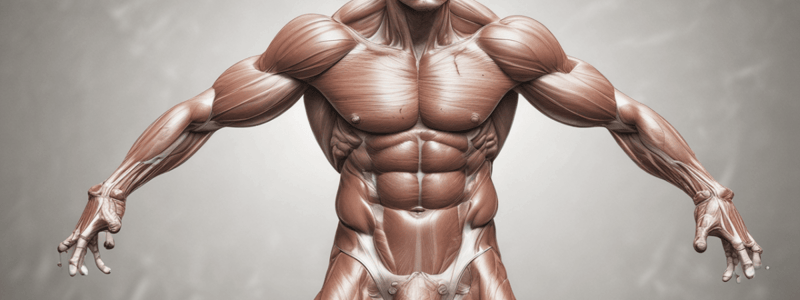Podcast
Questions and Answers
What are the characteristics of slow twitch fibres, and what type of activities are they designed for?
What are the characteristics of slow twitch fibres, and what type of activities are they designed for?
Slow twitch fibres have high mitochondrial density, high myoglobin content, high capillary density, low anaerobic capacity, and high aerobic capacity. They are designed for low-intensity, long-duration activities and are efficient for endurance activities.
What are the training adaptations of endurance training on slow twitch fibres?
What are the training adaptations of endurance training on slow twitch fibres?
Endurance training increases slow twitch fibre area, increases myosin heavy chain I expression, and increases mitochondrial density and capillary density.
What is the average distribution of muscle fibre types in humans, and what factors influence this distribution?
What is the average distribution of muscle fibre types in humans, and what factors influence this distribution?
The average distribution is 40-50% slow twitch fibres, 40-50% fast twitch fibres, and 10-20% intermediate fibres. The distribution is influenced by genetics, training and exercise, and muscle function and usage.
What are the characteristics of fast twitch fibres, and what type of activities are they designed for?
What are the characteristics of fast twitch fibres, and what type of activities are they designed for?
What are the subtypes of fast twitch fibres, and how do they differ in terms of anaerobic and aerobic capacity?
What are the subtypes of fast twitch fibres, and how do they differ in terms of anaerobic and aerobic capacity?
What are the characteristics of intermediate fibres, and what type of activities are they designed for?
What are the characteristics of intermediate fibres, and what type of activities are they designed for?
How do resistance training and endurance training affect muscle fibre distribution?
How do resistance training and endurance training affect muscle fibre distribution?
What is the role of genetics in determining muscle fibre distribution?
What is the role of genetics in determining muscle fibre distribution?
How does muscle fibre distribution affect athletic performance?
How does muscle fibre distribution affect athletic performance?
What are the implications of muscle fibre distribution for training and exercise?
What are the implications of muscle fibre distribution for training and exercise?
Flashcards are hidden until you start studying
Study Notes
Muscle Fibre Types
Slow Twitch Fibres (Type I)
- Also known as slow oxidative fibres
- Characteristics:
- High mitochondrial density
- High myoglobin content
- High capillary density
- Low anaerobic capacity
- High aerobic capacity
- Functions:
- Designed for low-intensity, long-duration activities
- Efficient for endurance activities
- High fatigue resistance
- Training adaptations:
- Increased mitochondrial density
- Increased myoglobin content
- Increased capillary density
Training Adaptations
- Resistance training:
- Increases fast twitch fibre area
- Increases myosin heavy chain IIb expression
- Endurance training:
- Increases slow twitch fibre area
- Increases myosin heavy chain I expression
- Increases mitochondrial density and capillary density
Muscle Fibre Distribution
- Varies among individuals and muscle groups
- Average distribution:
- Slow twitch fibres: 40-50%
- Fast twitch fibres: 40-50%
- Intermediate fibres: 10-20%
- Factors influencing distribution:
- Genetics
- Training and exercise
- Muscle function and usage
Fast Twitch Fibres (Type II)
- Also known as fast glycolytic fibres
- Characteristics:
- Low mitochondrial density
- Low myoglobin content
- Low capillary density
- High anaerobic capacity
- Low aerobic capacity
- Functions:
- Designed for high-intensity, short-duration activities
- High power output
- Low fatigue resistance
- Subtypes:
- Type IIa (fast oxidative glycolytic): high anaerobic capacity, moderate aerobic capacity
- Type IIb (fast glycolytic): high anaerobic capacity, low aerobic capacity
- Type IIx (fast intermediate): intermediate anaerobic and aerobic capacity
Intermediate Fibres (Type IIa)
- Characteristics:
- Intermediate mitochondrial density
- Intermediate myoglobin content
- Intermediate capillary density
- Intermediate anaerobic capacity
- Intermediate aerobic capacity
- Functions:
- Designed for moderate-intensity, moderate-duration activities
- Combination of high power output and moderate endurance
- Moderate fatigue resistance
Studying That Suits You
Use AI to generate personalized quizzes and flashcards to suit your learning preferences.




